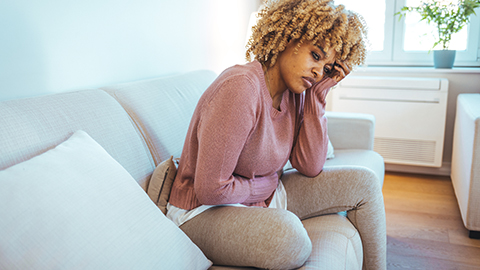
A client with chronic pelvic pain has been through the wringer, trying to get a solid diagnosis and effective treatment for what has—for lack of a better option—been diagnosed as levator ani syndrome.
Is there anything massage can do for this person? And is there a connection between levator ani syndrome and this client’s extreme flexibility? We explore these questions and more on this episode of “I Have a Client Who . . .”
Resources: 
Pocket Pathology: /abmp-pocket-pathology-app
Chronic Pelvic Pain in Women (no date). Available at: /textonlymags/article.php?article=1550 (Accessed: 2 May 2023).
Gilliam, E., Hoffman, J.D. and Yeh, G. (2020) ‘Urogenital and pelvic complications in the Ehlers-Danlos syndromes and associated hypermobility spectrum disorders: A scoping review’, Clinical genetics, 97(1), pp. 168–178. Available at: https://doi.org/10.1111/cge.13624.
Knowles, C.H. and Cohen, R.C. (2022) ‘Chronic anal pain: A review of causes, diagnosis, and treatment’, Cleveland Clinic Journal of Medicine, 89(6), pp. 336–343. Available at: https://doi.org/10.3949/ccjm.89a.21102.
Levator Ani Syndrome: Symptoms, Causes, and Treatment (2017) Healthline. Available at: https://www.healthline.com/health/levator-ani-syndrome (Accessed: 28 April 2023).
Massage & Bodywork - JULY | AUGUST 2016 (no date). Available at: http://www.massageandbodyworkdigital.com/i/694071-july-august-2016/44? (Accessed: 2 May 2023).
Myofascial Pelvic Pain (no date) Physiopedia. Available at: https://www.physio-pedia.com/Myofascial_Pelvic_Pain (Accessed: 2 May 2023).
Self-Care for Pelvic Pain—a Sensory Integration Toolkit by Sandy Hilton, PT, DPT, MS


0:00:01.4 Ruth Werner: Hello. I Have a Client Who... Listeners, Ruth Werner here, and I'm so excited to let you know that my library of online self-paced continuing education courses has just expanded. I now have a two-hour ethics course called, 'A Doctor's Note is Not Good Enough... And what is better.' This NCBTMB-approved course goes into why a doctor's permission or approval or even a prescription doesn't provide the legal or safety protection you might think it does. Then we look at how to start useful conversations with healthcare providers that will actually get us to safe and effective massage for our clients with complex conditions. Visit my website at ruthwerner.com for more information and to register for, 'A doctor's note is not good enough... And what is better.'
[music]
0:01:00.5 RW: Hi, and welcome to, 'I Have a Client Who... Pathology conversations with Ruth Werner.' The podcast where I will discuss your real life stories about clients with conditions that are perplexing or confusing. I'm Ruth Werner, author of 'A Massage Therapist's Guide to Pathology,' and I have spent decades studying, writing about and teaching about where massage therapy intersects with diseases and conditions that might limit our client's health. We almost always have something good to offer, even with our most challenged clients, but we need to figure out a way to do that safely, effectively and within our scope of practice, and sometimes as we have all learned, that is harder than it looks.
0:01:47.3 RW: Today's 'I Have a Client Who... ' story comes from a colleague who has sent me a few stories, and they always go out of their way to make my job easy, they provide so much information. But almost all I have to do is fill in a few missing pieces. You know who you are, contributor, and if you didn't already, now you know how much I appreciate you. That said, if you have an 'I Have a Client Who... ' story, you do not have to give me this level of input and detail, I'm perfectly happy to fill in these blanks, but I do appreciate it when someone makes my job easier like this. And I have edited this interaction just a bit for flow. To be clear, this massage therapist did check with the client to get permission to share all this information, and the story goes like this. I have a client who has been diagnosed with levator ani syndrome, which for her presents mainly with pain and spasms in the pelvic region. She's had this ongoing for more than 15 years. Like with many syndromes, the diagnosis came from ruling out other causes throughout the years, and after a few misdiagnoses as well. Her doctors have landed at levator ani syndrome as the best option, although there are still some questions.
0:03:04.2 RW: Okay, this is Ruth. And here's a short bit of information on levator ani syndrome, which is sometimes called pelvic myalgia. So you can get a sense of what this is about. Here's a situation where the pelvic floor muscles are too tight and they can't relax. In a way, it's sort of the opposite of a condition we talked about not long ago, pelvic organ prolapse, where those muscles in the pelvic floor are so slack that organs can protrude downward. But in levator ani syndrome, the levator ani muscle is pathologically tight, the person experiences chronic pain, problems with bowel and bladder function, painful sex, it can happen in males and females, but it is more common among those born with a uterus. A terrific discussion from the Cleveland Clinic describes it this way, they say levator ani syndrome involves chronic anal pain resulting from tension or spasms in the levator muscles leading to compression of nerve endings and pain via peripheral sensitization. Patients often describe a dull ache or pressure sensation in the rectum that is exacerbated by prolonged sitting and relieved by standing or lying down. Did you hear that part about the peripheral sensitization? That's really important. It refers to a pattern of sensation that the brain interprets as pain, even though no tissue damage might be occurring, and this can become a self-sustaining bad information loop, and that becomes really difficult to reverse.
0:04:41.0 RW: Okay, back to our story. Our contributor says, like many others with chronic pelvic pain, she's been down many different avenues, including various doctors, gynecologists, physical therapists, including pelvic pain specialists, urologists, and she attended a 12-week program on managing pain run by a pain psychologist department through a respected hospital. Unfortunately, she has not found relief. I would normally refer a client like this out to a pelvic pain physical therapist, but she's already been to so many, and that just doesn't seem to be a good fit for her right now. Okay, this is Ruth again. I really appreciate this massage therapist's sensitivity about this client's experiences. And while massage therapy probably won't solve this problem, it could certainly add to this person's quality of life. And here's what the Cleveland Clinic has to say about treatment for levator ani syndrome. Of the various treatments that have been studied, best evidence is for behavioral training with biofeedback. In a randomized controlled trial of 157 patients, one team compared behavioral training against direct neuromuscular stimulation using low voltage electric charge from a probe and massage. This show that 87% of patients reported adequate relief of rectal pain with bio-feedback versus 45% of patients with electrical stimulation and 22% with massage, and the improvement was maintained at 12 months.
0:06:15.1 RW: They go on to say that botox injections are often used here too, but the data on their effectiveness is not consistent. I wanna emphasize that the massage referred to in this study was conducted by physical therapists for whom this is within their scope of practice, or by using a device that the patient applies to their perceived internal trigger points, perineal massage is not within our scope of practice. Now, back to our contributor, when we started working together, I explained my limitations, no internal work, no work at the inter-gluteal cleft, and we decided together how we would proceed. We talked about the things she'd like to do if pelvic pain wasn't an issue, and we talked about how we could find ways for her to manage her pain so she can do some of those things, even if she has pain. We decided on 20-minute sessions, so we can see each other more often to start and now we've moved from once a week to once every other week, mostly. Our work consists of clothed sessions with work around the glutes, low back legs and hip, both anterior and posterior. We use a combination of longer myofascial type strokes, compression, kneading and other techniques with the intent of calming the nervous system, and I would say around a level three pressure, mainly on the Walton pressure scale with less on more sensitive areas.
0:07:38.6 RW: We have some temporary success using heat packs throughout the session and at the end of the session, working through the heat packs with my hands directly on the client, applying some gentle pressure both near the ischial tuberosity, which she finds takes some pressure off and temporarily stops the spasms, or at least provides some relief and dials down the pain signals for the moment. Here's Ruth again. Wow, this is wonderful and imaginative, 20-minute sessions that are accessible and convenient, make a lot of sense. Hot packs on the ischial tuberosity, that's something I would never have thought of, and the client can do some of this at home too, since it seems to offer some short-term relief. I will add that, of course, tightness and pain at the pelvic floor will reflect in all the surrounding muscles, the glutes and hips for sure, but also the adductors, the lower abdominal muscles, they all want to respond to that call for protection, and they all will alter the way a person stands, sits, walks, exercises and rests, so they are all good points of focus for pain management. Right. And now back to our contributor. Because chronic pelvic pain is multifaceted and affects more than just the primary area of pain, we also discuss at the beginning of each session if there's anything else that's come up since our last visit, so we can spend some time on other areas of stress, typically the neck and shoulders, if needed.
0:09:05.5 RW: Additionally, I have given her the physiotherapist, Sandy Hilton's book 'Why Pelvic Pain Hurts' for some pain education and some self-care tips that run beyond my scope of practice. Ruth here. I'm so glad this massage therapist is familiar with the work of Sandy Hilton. She is really a world class leading expert on pelvic pain, and I will put a link to her book in our show notes. Sandy is my go-to person for everything related to pelvic pain. Our contributor says, We are making some progress, but it's very temporary. My client has done an amazing job of creating a fulfilling life with travel, family and friends, despite her chronic condition, but as anyone with chronic pain knows, it's just a frustrating part of her everyday life. And now Ruth again, our contributor then lists a few more resources they have found about chronic pelvic pain in women, including an article I wrote inspired by spending some time with Sandy Hilton for massage and body work in 2016, and of course, this will be in the show notes. And they conclude with an interesting observation, the contributor says, One other thing that has stood out to me, but I can't find any correlation, is that the client is extremely flexible, in clinical terms, probably hyper-mobile, but they stated they don't meet the criteria for Ehlers Danlos syndrome. And I'm wondering if, although I wasn't able to find anything online, maybe hyper-mobility is somehow a factor in chronic pelvic pain or levator ani syndrome.
0:10:35.5 RW: Well, that's an interesting thought. And I pulled out my Google skills and I did find some data on this, I found one scoping review, that's a kind of project that collects a lot of studies on a fairly broad topic, that looked at findings for people with Ehlers Danlos syndrome and hyper-mobility spectrum disorders plus pelvic pain. And what do you know? There's a correlation there. This paper didn't address levator ani syndrome itself, but it did include data on chronic pelvic pain and the finding that various forms of pelvic pain are especially common in people with general hyper-mobility. Could it be that this client has some loose pelvic ligaments and her levator ani muscles are simply trying to hold her together? It's an interesting possibility. Physiopedia is another resource that I love to use for information about musculoskeletal things, and they list hyper-mobility as a contributing factor to pelvic myalgia. So it seems like, contributor, you're probably onto something here. But what does this all mean for our massage therapist and their client? Frankly, probably not a lot. There's no pill to take that will fix hyper-mobility, that is a lifetime project to balance out muscle tensions to achieve pain-free function.
0:11:58.0 RW: This client has been around the block a couple of times with so many different consultations and care providers and programs, and my sense is that at this point, she just wants to relax and feel good. And if her massage therapist can help her figure out ways to reduce her pelvic pain, even for a little while, that's a bonus. Our contributor concludes, I know that with chronic pain, many times we need to adjust our outcome goals, and I don't wanna fall into a 'fix it' mindset. But if I can assist this client in dialing down the pain and discomfort or work with them to ensure a good quality of life, that would be great. So I would love your thoughts. Well, my thoughts are these; There appears to be a decent correlation between pelvic pain and even specifically levator ani syndrome and hyper mobility. If you think it would be helpful and validating to your client to share that information with her, then use the resources in our show notes to do that. In the meantime, I think you're absolutely on the right track. I encourage you to maintain those good boundaries both about where we touch our clients, but also about what kinds of expectations we can have for our people who live with chronic pain. We can likely dial down the intensity of pain at least for a bit, and that's great, it can give people a different way to inter-react with their body in a loving relationship.
0:13:23.6 RW: This person seems to be capable of creating a full and meaningful life, even in the presence of this challenge. She's tried to find solutions on her own, and at some point, she may be ready to try again. But for now, you are being invited to be part of her coping strategy, and that seems clearly to be helping. What a privilege.
0:13:45.2 RW: Hey everybody, thanks for listening to 'I Have a Client Who..., Pathology Conversations with Ruth Werner.' Remember, you can send me your 'I Have a Client Who... ' stories to ihaveaclientwho@abmp.com. That's ihaveaclientwho@abmp.com. I can't wait to see what you send me and I'll see you next time.
[music]